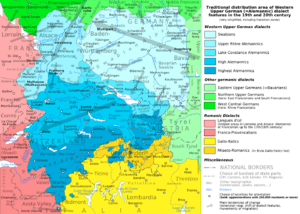Alemannic German facts for kids
Quick facts for kids Alemannic |
||||
|---|---|---|---|---|
| Alemannisch | ||||
| Native to | Switzerland: entire German-speaking part. Germany: most of Baden-Württemberg and Bavarian Swabia. Austria: Vorarlberg and some parts of Tyrol. Liechtenstein: entire country. France: most of Alsace. Italy: some parts of Aosta Valley and northern Piedmont United States: Amish in Adams and Allen counties, Indiana Venezuela: Alemán Coloniero |
|||
| Native speakers | 7,162,000 (2004–2012)e18 | |||
| Language family |
Indo-European
|
|||
| Writing system | Latin, Historically Elder Futhark | |||

Blue indicates the traditional distribution area of Western Upper German (=Alemannic) dialects.
|
||||
|
||||
Alemannic German (Alemannic German: Alemannisch) is a group of dialects. These dialects are part of the Upper German branch of the Germanic language family. Think of a language family like a tree, and dialects are different branches.
Around ten million people speak Alemannic German. They live in six different countries. These countries include southern Germany, Switzerland, France, Austria, Liechtenstein, and Italy. In Switzerland, people often call it Swiss German.
Unlike many other languages, Alemannic German is mostly a spoken language. There isn't one official way to write it down.
Contents
Where is Alemannic German Spoken?
Alemannic German is spoken in several European countries. It is also spoken in some parts of the Americas.
Alemannic in Europe
- Switzerland: Most people in the German-speaking parts of Switzerland use Alemannic dialects.
- Germany: You can hear it in most of Baden-Württemberg. It is also spoken in parts of Bavarian Swabia.
- Austria: It is common in Vorarlberg. Some parts of Tyrol also use it.
- Liechtenstein: This entire small country speaks Alemannic German.
- France: Most of the Alsace region uses these dialects.
- Italy: Some areas in the Aosta Valley and northern Piedmont speak it.
Alemannic Beyond Europe
- United States: Some Amish communities in Indiana speak a form of Alemannic.
- Venezuela: A special dialect called Alemán Coloniero is spoken there.
What is a Dialect?
A dialect is a way of speaking a language. It is specific to a certain area or group of people. Dialects can have different words, sounds, and grammar. They are still part of the same main language.
Alemannic German is a collection of these dialects. They are all related to each other.
Why is it Mostly Spoken?
Alemannic German does not have one standard way of writing. This means there is no single "correct" spelling for all its words. Because of this, it is mainly used for talking. People use it in their daily lives and conversations.
See also
 In Spanish: Alemánico para niños
In Spanish: Alemánico para niños

